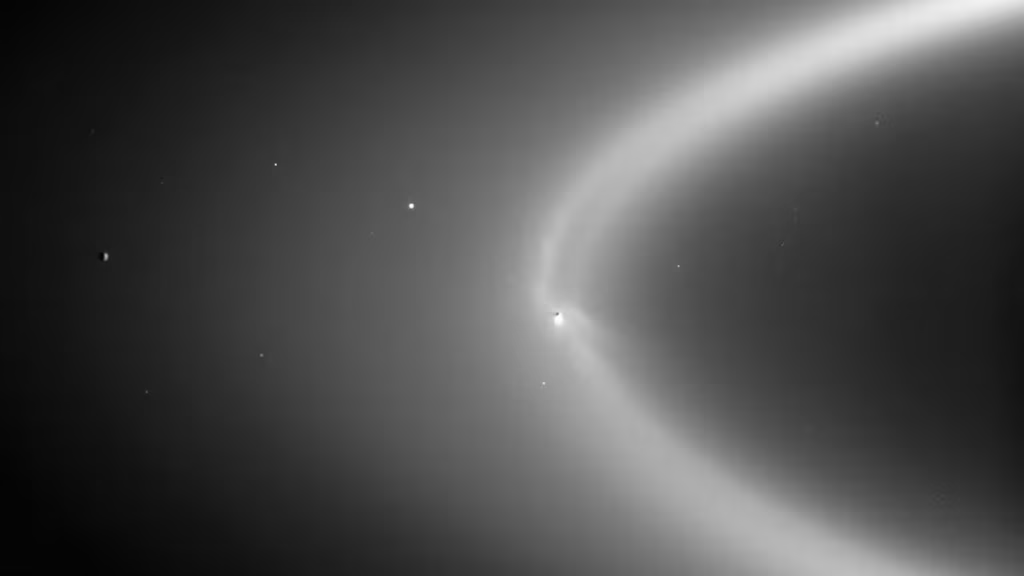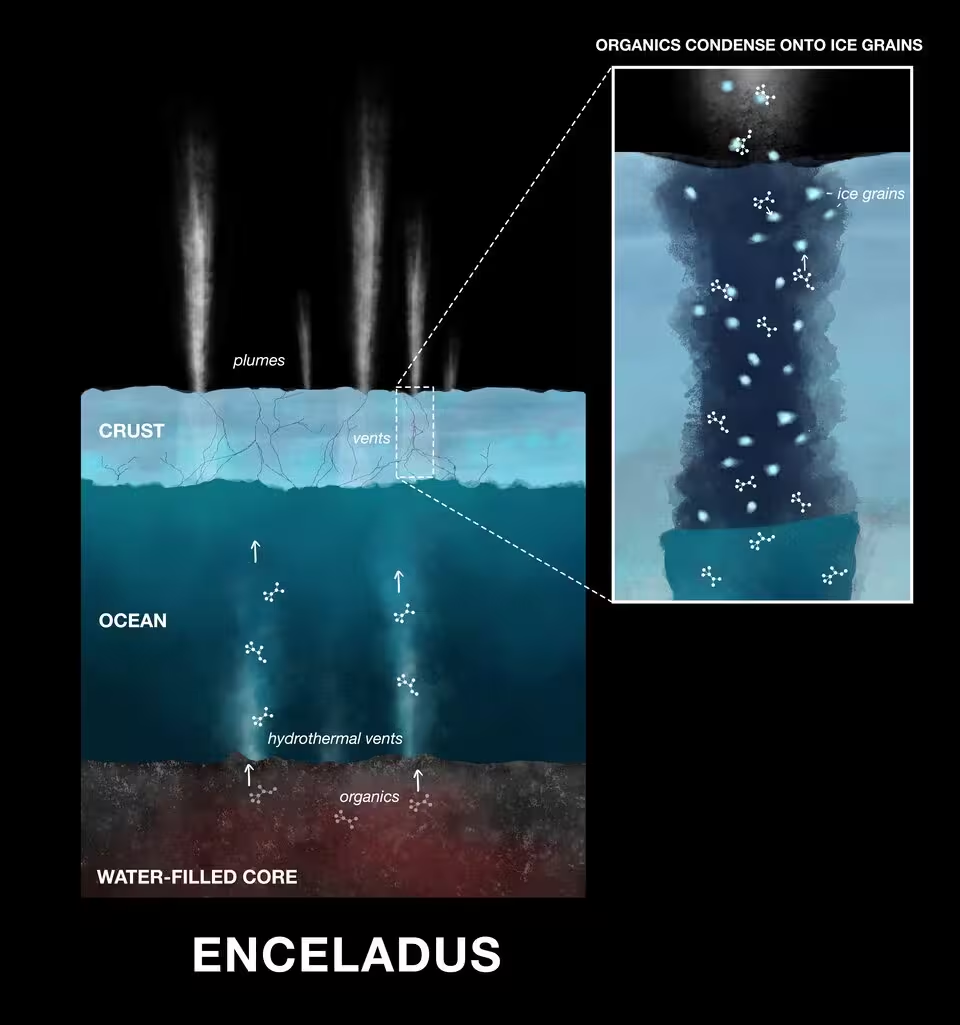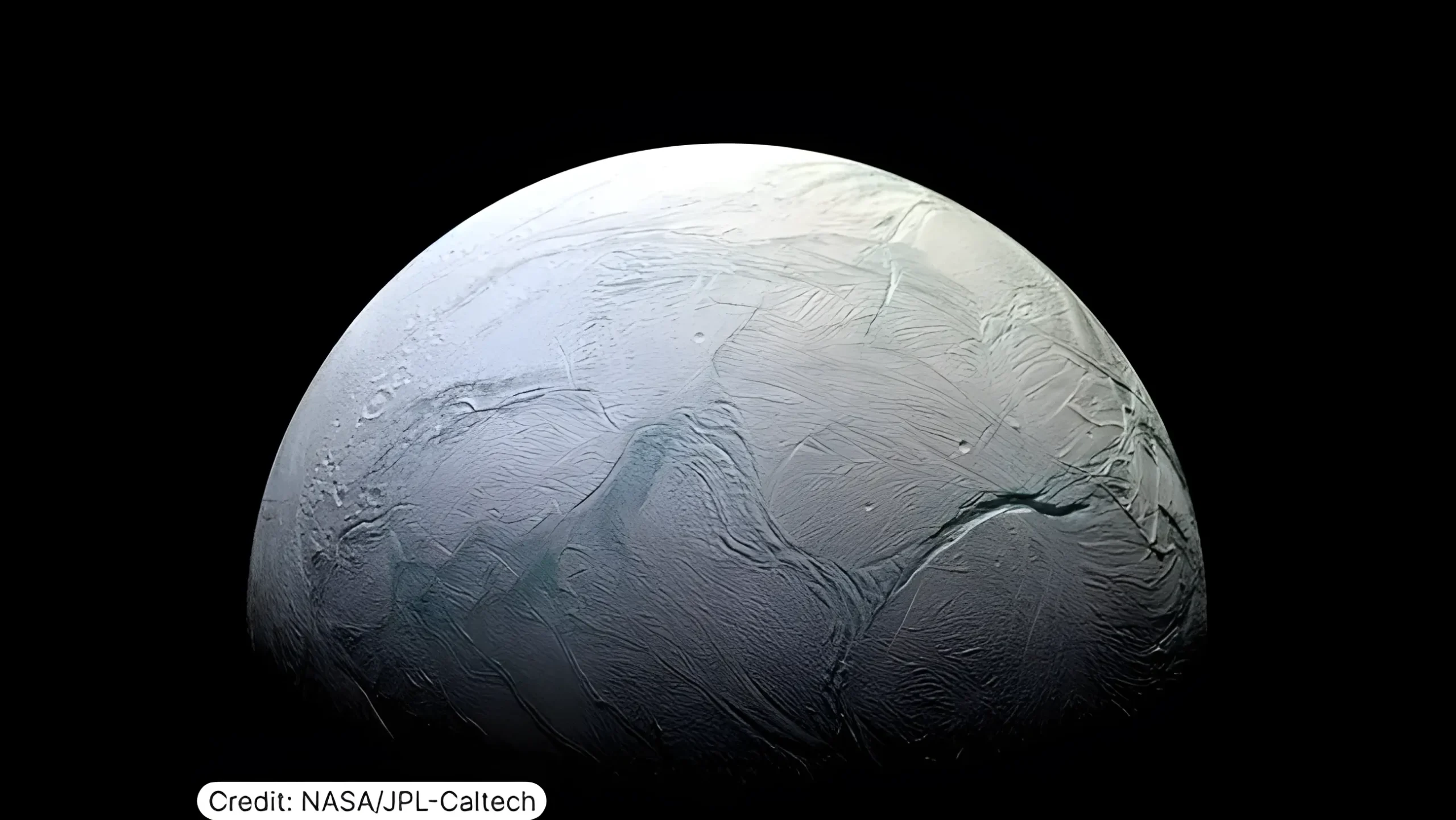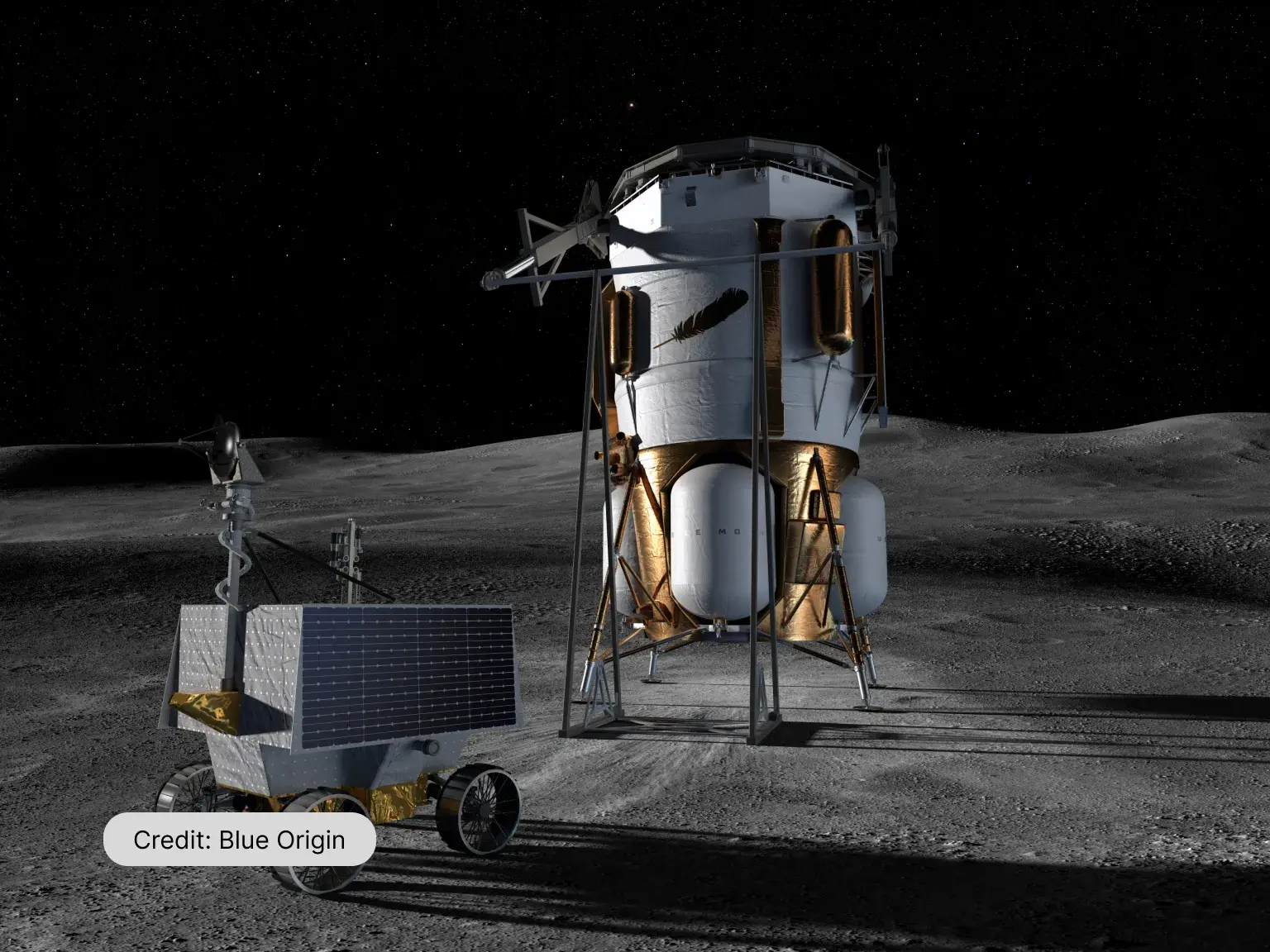When NASA’s Cassini spacecraft concluded its mission in 2017 with a dive into Saturn’s atmosphere, it left behind a treasure trove of data. Nearly a decade later, re-examined measurements from its October 2008 E5 flyby of Enceladus have yielded one of the strongest indications yet that Saturn’s icy moon harbors the chemical foundation for life. A detailed reanalysis published in Nature Astronomy (2025) confirmed that organic molecules sampled during the E5 flyby originated directly from Enceladus’s subsurface ocean.
This discovery underscores how archived data, combined with modern computational tools, can continue to generate transformative insights long after a spacecraft has gone silent.
Cassini’s E5 Flyby and the CDA Instrument
Encounter Details
- Date: October 9, 2008
- Closest Approach: 25 km above Enceladus’s south pole
- Speed: 17.7 km/s (E5 ‘At a Glance’).
- Region Sampled: freshly ejected plume grains near the south-polar vents.
This geometry allowed Cassini to pass directly through pristine cryovolcanic plumes, reducing ambiguity about whether organics formed in space or inside Enceladus.

The Role of the Cosmic Dust Analyzer (CDA)
Cassini’s CDA was a time-of-flight mass spectrometer that detected the chemical makeup of incoming grains by recording the plasma cloud created when an ice particle struck a rhodium target at high velocity. When the particle hit, it vaporized and ionized, producing a mix of charged fragments that were then accelerated through the instrument to a detector. By timing how long these ions took to travel the fixed distance, the CDA determined their mass-to-charge ratio, effectively creating a fingerprint of the particle’s composition. The instrument could track not only composition but also particle charge, velocity, trajectory, and mass, (sub-)micrometre-sized ice grains.
At E5 speeds, CDA spectra can also include Rh⁺ and Rh–H₂O⁺ peaks from the instrument’s rhodium target, which analysts account for when assigning organic fragments.
Why High-Speed Sampling Matters
Water-Cluster Interference
At lower velocities (6–12 km/s), water molecules from impacted grains tended to cluster into ion complexes like (H₂O)ₙH₃O⁺. These repetitive patterns formed a “curtain” of signals that masked faint organic signatures. This interference made it extremely difficult to isolate weak signals from more complex molecules because the repeating water-cluster peaks appeared regularly across the spectrum. In practical terms, this meant that any trace organics could easily be hidden within a dominant background pattern of water-derived ions.

The E5 Advantage
Near ~18 km/s, impacts dissociated water molecules into simple ions (H⁺, OH⁺, H₂O⁺) instead of clusters. The higher impact energy not only fragmented the water but also prevented the formation of large cluster complexes. This opened a clear spectral window, exposing hidden organic signals that had been invisible in thousands of lower-velocity spectra. The comparison shows how velocity acted almost like a natural filter, breaking down water interference and allowing organics to emerge more clearly.
Laboratory simulations using laser-induced liquid beam ion desorption (LILBID) confirmed this threshold effect: At lower encounter speeds (≲ 12 km/s), water-cluster ions can mask organics; at E5’s 17.7 km/s, these clusters are largely absent, revealing organic fragments. These experiments proved that high encounter speeds are not just helpful but essential in certain conditions for revealing complex chemistry in icy plume material.
| Parameter | Typical Flybys | E5 Flyby |
|---|---|---|
| Relative Velocity | 6–12 km/s | 17.7 km/s |
| Closest Approach | >50 km | 25 km |
| Sample Type | Aged E-ring grains | Fresh plume grains |
| Spectral Outcome | Masked organics | Clear organics |
Decoding Mass Spectra
Confirmed fragment classes in E5 spectra include aromatics, O-bearing organics, unsaturated chains (alkene-like), and ether-like fragments; additional features are candidate assignments pending higher-resolution confirmation.
Classification of Molecular Signatures
Reanalysis grouped CDA spectra into four broad categories:
- Aromatics: Characterized by peaks near m/z 77–79 (phenyl and benzenium ions), these signals point to single-ring aromatic structures such as benzene derivatives. Their presence suggests complex ring chemistry similar to molecules that play structural and functional roles in terrestrial biochemistry.
- Oxygen-bearing compounds: Fragments corresponding to aldehydes, esters, and small carbonyl molecules were observed. These oxygen-linked groups are often reactive intermediates and may participate in forming more elaborate prebiotic compounds.
- Esters/Alkenes: Spectra revealed chain-like fragments consistent with esters and unsaturated hydrocarbons. Such molecules indicate extended organic chemistry beyond simple volatiles and hint at pathways toward lipid-like structures.
- Ethers/Ethyls: Peaks near m/z 59 are associated with ethoxy fragments and ether linkages, both of which can act as bridges in larger organic molecules.
Beyond these classes, candidate features are heterocycles, amines, and nitriles (CDA impact spectra do not uniquely fix structures). On Earth, such functional groups participate in pathways that can yield amino acids and nucleotides; for Enceladus, these remain candidate identifications pending higher-resolution confirmation.
Laboratory Benchmarks
To confirm these identifications, spectra were matched against electron ionization (EI) libraries, including NIST Chemistry WebBook and MassBank databases. Laboratory simulations with Enceladus-analog solutions provided calibration for high-energy fragmentation.

Confirming Oceanic Origin
Fresh vs. Aged Material
- Fresh E5 Grains: Contained esters, ethers, and alkenes not seen in older E-ring grains.
- Aged Grains: Showed partial degradation from space weathering.
This confirmed that the newly detected compounds were oceanic in origin, not the product of cosmic radiation.
Hydrothermal Activity
Previous detections of silica nanograins (requiring >90 °C water-rock interaction) support the existence of hydrothermal vents. Five of the six CHNOPS elements (Carbon, Hydrogen, Nitrogen, Oxygen, Phosphorus, and Sulfur) have been detected, with one, such as Sulfur, still undetected. Enceladus presents a chemical toolkit strongly associated with habitability.
Lessons for Future Missions
Data Archiving as a Scientific Asset
Cassini ended in 2017, but its archived data continues to reveal insights. This demonstrates the importance of long-term data preservation and investment in open scientific archives.
Designing Next-Generation Missions
The findings directly inform future mission planning:
- NASA’s Enceladus Orbilander: A flagship concept prioritized in the 2023–2032 Decadal Survey, with viable launch windows in 2037/2038 (and again in the 2040s) leading to a landing under favorable south-pole illumination in the early 2050s; concept cost ~$2.56B (FY25$).
- ESA’s Proposed Mission: ESA has identified Enceladus as the top target for its next Large-class (Voyage 2050) mission; concepts under study include orbiter + south-polar lander with plume sampling, with schedule definition tied to the L-mission selection process (2040s–2050s).
These missions will be equipped with biosignature detection suites far more sensitive than Cassini’s CDA, capable of identifying amino acids, lipids, and nucleotides.
Conclusion: An Ocean World’s Chemical Toolkit
Cassini’s E5 flyby reanalysis shows that Enceladus harbors a diverse inventory of organic molecules, directly linked to its subsurface ocean. Aromatics, esters, ethers, and alkenes, combined with evidence for hydrothermal activity, strengthen the moon’s standing as a prime candidate for life beyond Earth.
The study highlights how data science, laboratory benchmarking, and thoughtful mission design can transform archived information into discoveries. As NASA and ESA look ahead to missions in the 2040s, the insights from Cassini emphasize that the search for life often begins by rethinking and reanalyzing the data already in hand.
Call-to-Action: For readers interested in planetary science, astrobiology, or data science, Enceladus stands as a reminder that progress often comes from carefully examining existing archives. Future missions will put these findings to the test, moving us closer to understanding whether life can emerge in alien oceans.





